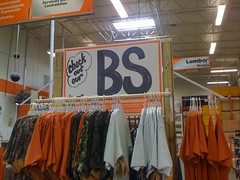I've been going through the results from our last industry poll on what a digital signage network should cost, and I'm planning to publish the results of that study in the near future. In reading the responses, I noticed some interesting differences between the answers given by people who have worked on larger projects, versus those who have predominantly worked on smaller ones. I was obviously expecting to see some differences in terms of what people expected to pay for components, or which services were deemed essential (or not), but even the words used by these people in the course of their open-ended responses differed substantially. This got me thinking about the vocabulary and parlance that I use every day, and how I change it (or don't) depending on who I'm talking to.
Words that need to go away
A few weeks ago, Dave Haynes wrote a great post on his Buzz, Not Buzzwords blog about some common buzzwords and phrases that really ought to be shelved, at least during polite conversation. ("Best of breed", I'm looking at you.) It's one thing for press releases and marketing documents to use ridiculous phrases -- I think we've all come to expect that by now, and with practice we've learned to more or less ignore them. However, I'm still stunned when people tell me about their n-tiered, next-generation solutions in casual conversation (which also tells you about the kind of "casual" conversation I usually find myself taking part in). In addition to minding Dave's excellent list, I will be doing my best to avoid using the words leverage, dynamic and anything that has to do with synergy. I sincerely hope you'll try to avoid them too :)
A sign, by any other name...
Long before I started running surveys and taking polls, it was evident that our industry had something of an identity crisis. One man's digital sign was another's electronic display. Captive audience networks were all the rage, until people started realizing that their audiences weren't really captive (aside from those few prison-focused applications). These days, digital out-of-home, or DOOH, seems to have become the de-facto industry acronym, despite the silly sound. But try using that on anybody unfamiliar with the industry -- including those folks who have done their fair share of smaller digital signage projects -- and you'll be greeted with blank stares, funny looks, or worse. Consequently, I stick almost exclusively to "digital signage" when talking about indoor screens and networks, and "electronic billboards" when talking about the big, side-of-the-road displays. From what I've seen of the open-ended responses of this last survey, it looks like most of you agree with that approach. I do find myself occasionally using the phrase "digital out of home," but only in the context of advertising, since "out of home" has been used commonly in ad circles for quite some time.
Referring to big networks versus small
In addition to the myriad words and phrases that could be said instead of "digital signage," I started to notice that those respondents who typically worked on smaller digital signage projects tended to use different words than those who worked on larger ones. Specifically, the folks from smaller projects more frequently used tech-sounding words like "displays," "screens" and "monitors," while those accustomed to larger projects almost never used such words. This might point to the different mentalities of the companies running each type of project. An AV integrator may have made a successful business out of installing digital screens for messaging in many of the local businesses, churches and schools in his area. But if the projects were heterogeneous and largely self-contained, he probably continued to think of them as technical installations of screens and media players. The function of the screens was ancillary. On the other hand, nobody is going to install a 2,000 screen network unless they have a very clear idea of what those screens will be used for -- and usually that means having some kind of digital signage content strategy. Consequently, large network deployers frequently used terms like "media" and "network" in their descriptions, which were uncommon in the responses from smaller integrators.
So while I'll start talking about more substantive results from the survey in the coming weeks, these preliminary, anecdotal findings have taught me that nothing -- including industry parlance -- is a truly settled matter in this business. Part of that is because as we grow, new people and companies from very different markets are getting involved, bringing with them their own perspectives and vocabularies. Plus, some people really just like to throw around marketing schlock, and apparently there's nothing we can do to stop them. I'm hopeful that somebody will eventually figure out how to prevent these people from synergizing their backward overflow dynamics. Until then, I'm leaving my BS filter on.
The difference in terminology for large and small networks is new and interesting to me. What terms do you use for the kinds/sizes of networks you're most familiar with? Leave a comment below and let us know!


 Subscribe to the Digital Signage Insider RSS feed
Subscribe to the Digital Signage Insider RSS feed
Comments
RSS feed for comments to this post